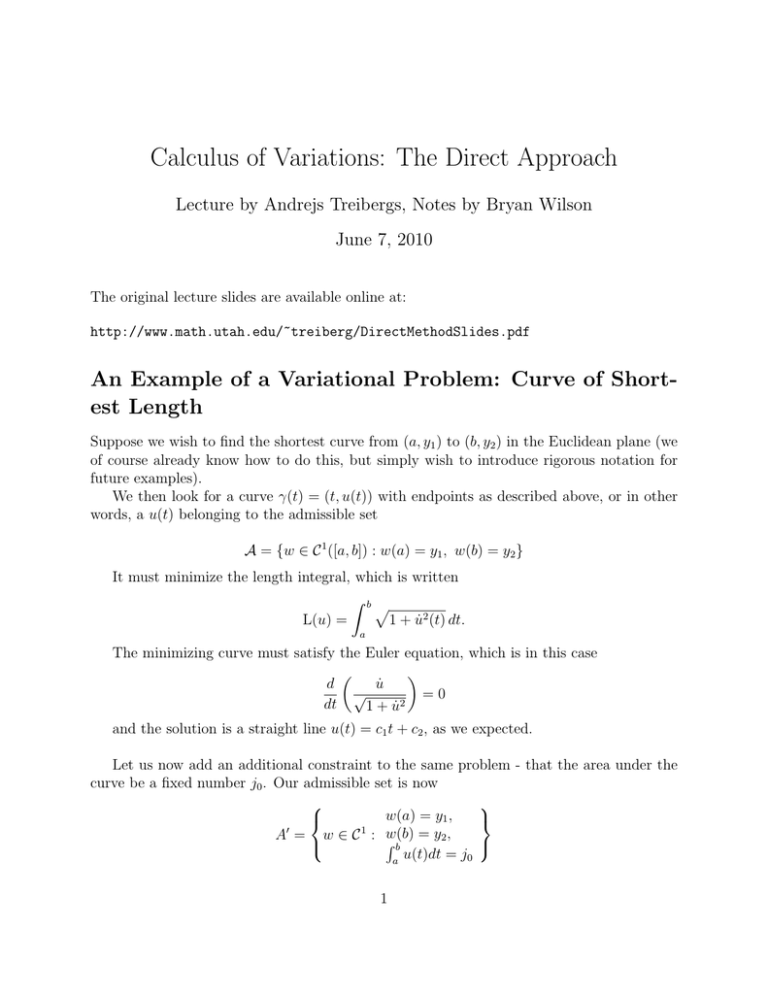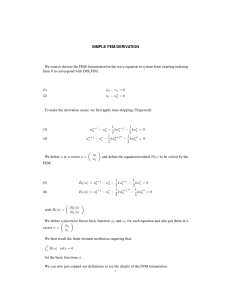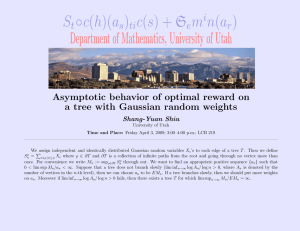Calculus of Variations: The Direct Approach June 7, 2010
advertisement

Calculus of Variations: The Direct Approach
Lecture by Andrejs Treibergs, Notes by Bryan Wilson
June 7, 2010
The original lecture slides are available online at:
http://www.math.utah.edu/~treiberg/DirectMethodSlides.pdf
An Example of a Variational Problem: Curve of Shortest Length
Suppose we wish to find the shortest curve from (a, y1 ) to (b, y2 ) in the Euclidean plane (we
of course already know how to do this, but simply wish to introduce rigorous notation for
future examples).
We then look for a curve γ(t) = (t, u(t)) with endpoints as described above, or in other
words, a u(t) belonging to the admissible set
A = {w ∈ C 1 ([a, b]) : w(a) = y1 , w(b) = y2 }
It must minimize the length integral, which is written
Z bp
1 + u̇2 (t) dt.
L(u) =
a
The minimizing curve must satisfy the Euler equation, which is in this case
d
u̇
√
=0
dt
1 + u̇2
and the solution is a straight line u(t) = c1 t + c2 , as we expected.
Let us now add an additional constraint to the same problem - that the area under the
curve be a fixed number j0 . Our admissible set is now
w(a) = y1 ,
1
0
= y2 ,
A = w ∈ C : w(b)
Rb
u(t)dt = j0
a
1
This is called the Isoperimetric Problem. As shown in the proof outline below, we will
see that the associated Euler-Lagrange equations demand the minimum-length curve have
constant curvature, thus must be an arc of a circle. Note that in some cases there may be
no minimum.
We may solve a more general problem by letting Ω ⊂ Rn be a bounded domain with
smooth boundary (to act as the interval [a, b] from before) and letting φ ∈ C 1 (Ω) be the
boundary conditions. We then look for functions u(t) that maximize some
Z
f (x, u(x), Du(x)) dx
I(u) =
Ω
subject to the constraint that
Z
J(u) =
g(x, u(x), Du(x)) dx = j0
Ω
In our previous problem, I(u) was the negative of arc length and J(u) was the area under
the curve u(t).
Look at two-parameter variations U (x, ε1 , ε2 ) = u(x) + ε1 η1 (x) + ε2 η2 (x), where η1 (z) =
η2 (z) = 0 are smooth functions which vanish on the boundary of Ω. Thus U is in our
admissable set. Define the following:
Z b
I(ε1 , ε2 ) =
f (t, U, DU ) dx
a
Z b
g(t, U, DU ) dx
J(ε1 , ε2 ) =
a
Note that I is at a maximum when ε1 = ε2 = 0
Using Lagrange Multipliers, there is a constant λ so that the solution is the critical point
of the Lagrange function
Z b
L(ε1 , ε2 ) = I(ε1 , ε2 ) + λJ(ε1 , ε2 ) =
h(t, U, DU ) dt
a
where
h(t, U, DU ) = f (t, U, DU ) + λg(t, U, DU ).
We may use this to find the weak Euler-Lagrange Equations
Z b
∂L ∂h
=
ηi + Dp h • Dx ηi dx = 0,
∂εi ε1 =ε2 =0
∂u
a
Integrating by parts (which we assume is OK) yields
Z b ∂h
ηi
− div (Dp h) dt = 0.
∂u
a
2
And remembering that ηi are arbitrary, this can only hold if
∂h
− div (Dp h) = 0.
∂u
Returning to the original isometric problem we were interested in and plugging in values,
we have
√
h = f + λg = 1 + u̇2 + λu.
Inserting this into the Euler-Lagrange Equation and with some algebraic manipulation,
we get that 0 = λ − κ, or in other words, that the curvature κ is a constant not dependant
on t. This means our solution is an arc of a circle.
Dirichlet’s Principle and Hilbert
Dirichlet’s Principle is derived from an electrostatics problem: If two electric battery poles
are attached at points to a thin conducting sheet, the potential across the sheet is the solution
of a boundary value problem, and one can look for a solution which produces minimal heat.
Generalizing,
Dirichlet’s Principle. Let G ⊂ R2 (or in a smooth surface) be a compact domain and
φ ∈ C(∂G). Then there is u ∈ C 1 (G) ∩ C(G) that satisfies u = φ on ∂G and minimizes the
Dirichlet Integral
Z
|Du|2 dA.
D[u] =
Moreover, ∆u = 0 on G.
G
Dirichlet was mistaken in assuming a minimizer must exist. Weierstrass found the flaw
and Hilbert finally proved the principle rigorously (but assuming appropriate smoothness).
Hilbert later (in his list of famous problems to attack in the 20th century) suggested the
following avenues be explored in Calculus of Variations: Are solutions of regular variation
problems always analytic? Does a solution always exist, and if not, when are we sure that a
solution must exist? Also, can we always modify the definition of ’solution’ in a meaningful
way for any problem?
Due to these questions, much progress was made in the 20th century.
The Direct Method
The direct method for solution to minimization problem on a functional F(u) is as follows:
Step 1: Find a sequence of functions such that F(un ) → infA F(u)
Step 2: Choose a convergent subsequence un0 which converges to some limit u0 . This is
the candidate for the minimizer.
Step 3: Exchange Limits:
3
F(u0 ) = F
0
lim
u
= lim
F(un0 ) = I.
n
0
0
n →∞
n →∞
There are obviously issues with assuming some of the above steps are possible, for example:
1) There may not be a lower bound.
2) The set A of admissible functions may not be compact.
3) Only allowed to exchange limits if F is lower-semicontinuous
With ’nice’ enough spaces and functions, though, the direct method assures existence of
a minimizing solution.
Illustration with Poisson Minimization Problem
The Poisson minimization problem uses the following functional:
R
F(u) = Ω 12 |Du|2 + ψu dx.
Here, ψ ∈ L2 (Ω) and φ ∈ C 1 (Ω).
The Euler Equation is
0 = ψ − div(Du)
This is usually written u = φ on ∂Ω, ∆u = ψ in Ω and is Poisson’s Equation.
We will see using the direct method that the following theorem holds true:
Poisson’s Minimization Problem.
Let Ω ⊂ Rn be a bounded, connected domain with smooth boundary. Let φ, ψ ∈ C ∞ (Ω).
For u ∈ C 1 (Ω), let
R
F(u) = Ω 12 |Du|2 + ψu dx.
Then there is a unique u0 ∈ C ∞ (Ω) with u0 = φ on ∂Ω such that
F(u0 ) = inf 0 F(u)
u∈A
where A0 = u ∈ C(Ω) ∩ C 1 (Ω) : u = φ on ∂Ω.) . Also, ∆u0 = ψ in Ω.
Note: We enlarge the space of admissible functions using the Hilbert Space:
(
)
all distributional derivatives
∂u
H1 (Ω) := u ∈ L2 (Ω) : exist and ∂x
∈ L2 (Ω) for all
i
i.
This makes sense because to prove an inequality, you only need to prove it on a dense set,
and H1 (Ω) is the completion of C ∞ (Ω). Similarly denote by H01 (Ω) the completion of C0∞ (Ω).
Denote by A1 the extension of A0 to this Hilbert space, as follows:
A1 := u ∈ H1 (Ω) : u − φ ∈ H01 (Ω) .
4
Coercivity. We need to address the three issues listed above to make sure the direct
method is going to work. Our first task is to prove F is bounded below (coercive).
Lemma: There are constants c1 , c2 > 0 depending on ψ and Ω so that for all u ∈ A1 ,
F(u) ≥ c1 kuk2H1 − c2 .
It follows easily that F is bounded below by −c2 and
I = inf1 F(v)
v∈A
exists and is finite. The proof is a bit involved and is not included here. We now know that
we may choose a minimizing sequence un ∈ A1 so that
lim F(un ) = I.
n→∞
Compactness. We can assume F(un ) < I + 1 for all n by renumbering, so
kun kH1 ≤
I + 1 + c2
.
c1
FACT: In any Hilbert Space, e.g. in H1 , any bounded sequence {un } is weakly sequentially
compact: there is a subsequence {un0 } that weakly converges in H1 to u0 ∈ H1 . That is, for
any v ∈ H1 ,
hun0 , viH1 → hu0 , viH1
as n0 → ∞.
FACT: The embedding H1 (Ω) ⊂ L2 (Ω) is compact. i.e., by going to a sub-subsequence if
necessary, we may assume un00 → u0 in L2 (Ω).
FACT: A1 is a closed subspace of H1 (Ω). If all un0 belong to a closed subspace and {un0 }
converges weakly to u0 in H1 , then u0 also belongs to the closed subspace. i.e., u0 ∈ A1 .
u0 is the candidate to be the minimizer of the variational problem.
Lower Semi-Continuity. We need this in order to switch the order of F and the limit
in Step 3 of the Direct Method.
Lemma: Let un be a minimizing sequence for F(u) such that un → u0 strongly in L2 (Ω)
and weakly in H1 (Ω). Then
F(u0 ) ≤ lim inf F(un ).
n→∞
R
R
Proof. Since un → u0 in L2 (Ω), Ω ψun → Ω ψu0 and kun kL2 → ku0 kL2 .
5
In any Hilbert Space the norm is SWLSC: ku0 kH1 ≤ lim inf n→∞ kun kH1 .
Z
Z
2
2
2
1
1
1
F(u0 ) = 2 kDu0 kL2 + ψu0 = 2 ku0 kH1 − 2 ku0 kL2 + ψu0
Z
2
2
1
1
≤ lim inf 2 kun kH1 − 2 kun kL2 + ψun = lim inf F(un ) = I.
n→∞
n→∞
Uniqueness of Solution. Uniqueness follows from the convexity of the functional F(u),
which we must define.
F ∈ C 1 is convex on A1 ⊂ H1 if
F(u + w) − F(u) ≥ DF(u)[w] whenever u, u + w ∈ A1 .
F is strictly convex if “=” holds iff w = 0.
We have not yet proven F ∈ C 1 so this is the first step in the argument. By definition,
this is true if F is differentiable and DF : H1 → (H1 )∗ is continuous. We prove them here.
F is differentiable:
|F(u + v) − F(u) − DF(u)[v]| =
1
2
R
Ω
|Dv|2 dx ≤ 21 kvk2H1 = o (kvkH1 ) as kvkH1 → 0.
DF is continuous: For u, v, w ∈ H1 ,
Z
|DF(u)[w] − DF(v)[w]| = (Du − Dv) · Dw dx
Ω
≤ kD(u − v)kL2 kDwkL2 ≤ ku − vkH1 kwkH1 .
Thus
|DF(u)[w] − DF(v)[w]|
→0
kwkH1
w6=0
kDF(u) − DF(v)k(H1 )∗ = sup
as ku − vkH1 → 0.
It is easily checked that our particular F in the Poisson problem is convex, so it follows
with some work that the solution is unique.
What have we shown?
Using the Direct Method, we showed the existence of a unique weak solution u0 ∈ H1 of
the Dirichlet problem for Poisson’s Equation. If the coefficients are known to be smoother
(smooth boundary, smooth ψ and φ) then the solution u will also have more regularity.
6






